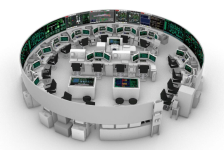What is that in non Naval speak
Long ass explanation below, and not sure if there is an army equivalent. We have a whole doctrine set for all the stuff happening inside the ship (aka the internal battle) as well as what is going on outside the ship (external battle), which adds some extra on when in a task group or other external assets (like aircraft or land support). I guess one difference is that there is a baseline risk of things like onboard fires, floods and collisions at sea (or allisions alongside I guess) so there is a lot of things you do for peacetime sailing that army doesn't need to have a system in place for day to day routine operations.
MCR is the machinery control room, and where you run the machinery plant out of. Depends on the class, but you'll have some control consoles for monitoring as well as to be able to control things like propulsion, power generation and all the other machinery systems. You'll also have things like controls for ventilation and fitted fire suppression and flood systems, with SOPs for initial response.
For the control system, you'll see the acronym 'Integrated Platform Managment System (IPMS)', which is also used in commercial industry, but the L3 system was really developed off the original "Integrated Machinery Control System' (IMCS) which was a really innovative Canadian thing developed for the CPFs, and then retrofit onto the 280s that was a lot more interconnected then previous analogue and early digital setups on ships.
Because it's all digital, it's very easy to have duplicate displays all over the place, but for control purposes different locations are normally set up in a hierarchy with more limited control capabilities by default, and then different consoles in limited locations tailored for specific users. So the one on the bridge has some physical buttons for things like standard speed inputs, and the ones in the MCR have different hard and soft buttons for common functions and emergency things like a battle overide button that disables all the software safeties so you can run equipment to failure if necessary in an emergency to prevent worse stuff happening in emergencies.
Normal posture depends on the ship class, but typically on warships you will have some people on watch actively monitoring the plant in the MCR. On something like AOPs you won't have someone actively monitoring on watch unless you are doing something higher risk like a RAS or coming in and out of harbour, but your maintainers on watch will get notified something is wrong and will respond to that. Because it's a non-combatant you can safely automate that response for the most part, so will do things like switch over engines or generators automatically for you (assuming they are available). There is a lot less redundancy built in though, so really can't afford to go to sea with a lot of things not working.
HQ1 is the main headquarters during an emergency, and where the damage control officer DCO(usually the engineer) and damage control PO go to coordinate the fire/flood teams throughout the ship (usually set up with a forward and aft section base, plus a few others spread around for survivability), with the DCO is coordinating with the other departments doing first aid, helo ops and combat equipment support.
Usually co-located normally with the MCR, so that the DCO and DCPO can talk with the senior electrician and Chief Eng who is maintaining propulsion, but doesn't necessarily have to be.
There are alternate locations for both the MCR and HQ1, as well as some local control stations where you can drive the engines, switchboards, steering etc directly. Without the consoles you can still take the computer based systems and log in other spots, but without the interface and number of screens it's a lot harder to do.
Because we've intergrated a lot of things, you can do things like pull up all the CCTV feeds, monitor the power plant, and track the damage control overlay so with a few big screens you can track and do a lot of things from the same spot. With the different log ins and hierarchy, you can set it up so you can get screens to just monitor only, and that's usually how it's set up for the combat operators (aka dibs) so they can watch things like the flight deck camera, but can't accidentally trip a propulsion engine or whatever.
One challenge for all this is that you now have access to a huge amount of live data and can be on a lot of comm channels at the same time, so we put a lot of effort into things like the human machine interface, comms setups etc, so that the people doing the 'internal battle' and 'external battle' can focus on their bit, with some people coordinating/monitoring between them but it's something that takes a lot of individual and collective training to actually get good at, so why we do a lot of continual training, and if you get too many postings some of the collective qualifications are voided.






